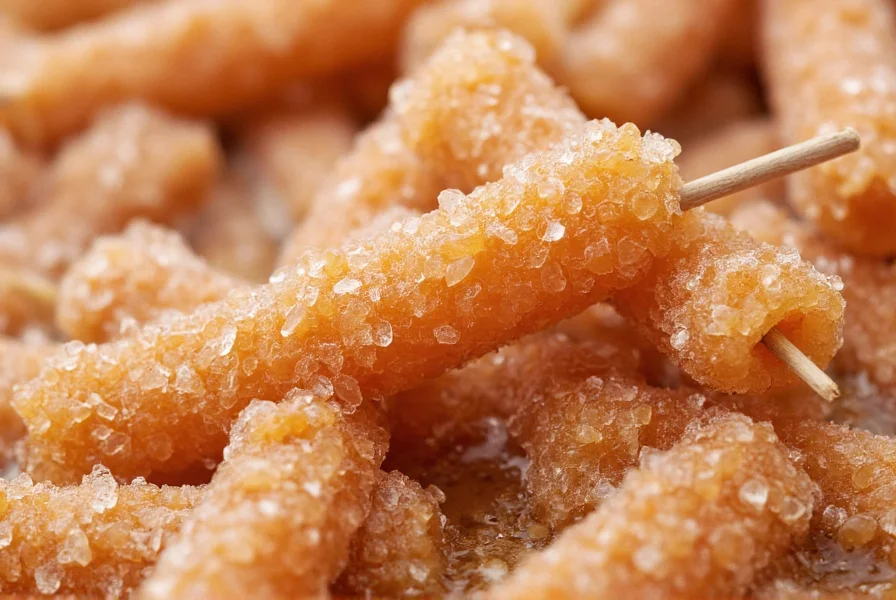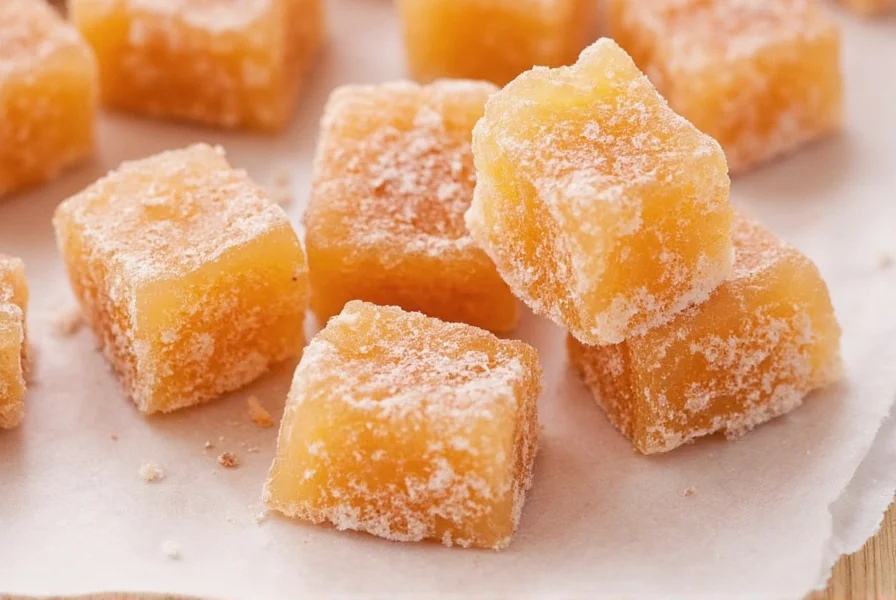Here's the direct answer: A classic cinnamon rock candy recipe requires 2 cups of granulated sugar, 1/2 cup of water, 1/2 teaspoon of ground cinnamon, and 1/4 teaspoon of cream of tartar. Dissolve sugar in water over medium heat, add cinnamon and cream of tartar, then simmer without stirring until the mixture reaches 300°F (hard crack stage). Pour into molds or onto parchment paper to cool and crystallize. The entire process takes about 15 minutes active time with 2-3 hours for cooling.
The Science Behind Perfect Cinnamon Rock Candy
Making cinnamon rock candy isn't just fun—it's a fascinating demonstration of sugar crystallization. Unlike regular hard candy, rock candy forms large, visible crystals through a controlled cooling process. The addition of cinnamon creates a warm, spicy contrast to the intense sweetness, making it a beloved treat across many cultures.
Why This Cinnamon Rock Candy Recipe Works
Many homemade cinnamon rock candy recipes fail because they don't properly manage the crystallization process. This tested recipe includes cream of tartar, which prevents premature crystallization during cooking while allowing controlled crystal formation as the syrup cools. The precise 2:1 sugar-to-water ratio ensures proper saturation for optimal crystal growth without being too brittle.

Ingredients Deep Dive
Understanding each component helps you master this homemade cinnamon rock candy recipe:
| Ingredient | Amount | Why It Matters |
|---|---|---|
| Granulated sugar | 2 cups | Provides the crystal structure foundation; superfine sugar won't work as well |
| Water | 1/2 cup | Dissolves sugar initially; too much water prevents proper crystallization |
| Ground cinnamon | 1/2 tsp | Use freshly ground for best flavor; pre-ground loses potency quickly |
| Cream of tartar | 1/4 tsp | Prevents graininess while allowing controlled crystal formation |
| Cinnamon oil (optional) | 3-4 drops | Boosts flavor without affecting crystallization process |
Essential Equipment for Success
Having the right tools makes your easy cinnamon rock candy instructions foolproof:
- Candy thermometer (essential for accurate temperature reading)
- Heavy-bottomed saucepan (prevents scorching)
- Heatproof spatula or wooden spoon
- Glass or ceramic molds (metal conducts heat too quickly)
- Parchment paper-lined baking sheet
- Optional: Wooden sticks for traditional rock candy formation
Step-by-Step Cinnamon Rock Candy Instructions
Follow these precise steps for perfect results every time with this step-by-step cinnamon rock candy guide:
- Prepare your workspace: Line a baking sheet with parchment paper and have molds ready
- Combine sugar, water, and cream of tartar in saucepan over medium heat
- Stir gently until sugar dissolves completely (about 3-4 minutes)
- Stop stirring and insert candy thermometer
- Cook without disturbing until mixture reaches exactly 300°F (hard crack stage)
- Remove from heat and carefully stir in cinnamon (and optional cinnamon oil)
- For stick candy: Dip sticks in cold syrup, then coat with granulated sugar before pouring hot syrup over them
- Pour syrup into prepared molds or onto parchment paper
- Let cool undisturbed at room temperature for 2-3 hours
- Break into pieces and store in airtight container
Troubleshooting Common Problems
Even with careful attention to your cinnamon flavored rock candy making, issues can arise:
- Crystals won't form: Temperature wasn't high enough (must reach 300°F) or mixture was stirred after sugar dissolved
- Candy is cloudy: Impurities in the mixture; use filtered water and clean equipment
- Candy is too brittle: Overcooked; remove from heat immediately when reaching 300°F
- Weak cinnamon flavor: Use higher quality cinnamon or add 3-4 drops cinnamon oil at the end
- Crystals are too small: Mixture cooled too quickly; let sit at room temperature rather than refrigerating
Storage and Serving Suggestions
Proper storage is crucial for maintaining the quality of your storing homemade cinnamon rock candy. Keep in an airtight container at room temperature away from humidity. Place parchment paper between layers to prevent sticking. Properly stored, it will stay crisp for 2-3 weeks.
Serve cinnamon rock candy in small portions due to its intense sweetness. It makes an excellent after-dinner treat, pairs wonderfully with strong coffee or tea, and can be crushed and used as a garnish for desserts. For a traditional experience, serve on a decorative dish alongside other small candies.
Delicious Variations to Try
Once you've mastered the basic traditional rock candy with cinnamon, experiment with these variations:
- Spiced Cinnamon: Add a pinch of cloves, allspice, and nutmeg for holiday flavor
- Double Cinnamon: Use cinnamon extract along with ground cinnamon for intense flavor
- Colored Candy: Add a single drop of red food coloring for traditional red cinnamon candy
- Layered Candy: Pour thin layers, allowing each to partially set before adding the next
- Infused Flavors: Steep cinnamon sticks in the water before adding sugar for more complex flavor
Perfecting Your Cinnamon Rock Candy Technique
The key to exceptional perfect cinnamon rock candy technique lies in temperature control and patience. Never rush the cooling process—rock candy needs time to form those beautiful crystals. If making stick candy, ensure your sticks are completely dry before dipping, as any moisture will prevent proper crystallization.
For the clearest crystals, avoid any disturbance during the cooling phase. This means no moving the molds, no covering, and keeping the area free from vibrations. The slower the cooling process, the larger the crystals will grow, creating that signature rock candy appearance.
How long does cinnamon rock candy last when properly stored?
When stored in an airtight container at room temperature away from humidity, cinnamon rock candy will maintain its crisp texture for 2-3 weeks. Place parchment paper between layers to prevent sticking. Exposure to moisture is the primary cause of deterioration, causing the candy to become sticky or dissolve.
Why isn't my cinnamon rock candy forming crystals properly?
The most common reasons for poor crystallization are: temperature not reaching exactly 300°F (hard crack stage), stirring the mixture after the sugar dissolved, using impure water, or cooling the candy too quickly. For best results, use a reliable candy thermometer, avoid disturbing the syrup once cooking begins, and let it cool undisturbed at room temperature.
Can I use cinnamon sticks instead of ground cinnamon in rock candy?
Yes, you can use cinnamon sticks for a more subtle flavor. Steep 2-3 cinnamon sticks in the water before adding sugar, then remove them before the mixture reaches boiling. For stronger flavor, you'll still need to add a small amount of ground cinnamon or cinnamon oil at the end of cooking, as the sticks alone won't provide enough concentrated flavor for rock candy.
What's the purpose of cream of tartar in cinnamon rock candy?
Cream of tartar serves two critical functions: it prevents premature crystallization during cooking (which would make the candy grainy), while still allowing controlled crystal formation as the syrup cools. Without it, your cinnamon rock candy would likely develop small, uneven crystals or become too brittle. Use the recommended 1/4 teaspoon for best results with this traditional rock candy recipe.
How can I make cinnamon rock candy with larger crystals?
To encourage larger crystal formation, cool the candy more slowly at room temperature rather than in a cool environment. For stick candy, ensure your sticks have a light coating of undissolved sugar before pouring the hot syrup over them, as this provides nucleation points for crystal growth. Avoid any disturbance during the cooling process, as movement prevents large crystals from forming properly.











 浙公网安备
33010002000092号
浙公网安备
33010002000092号 浙B2-20120091-4
浙B2-20120091-4